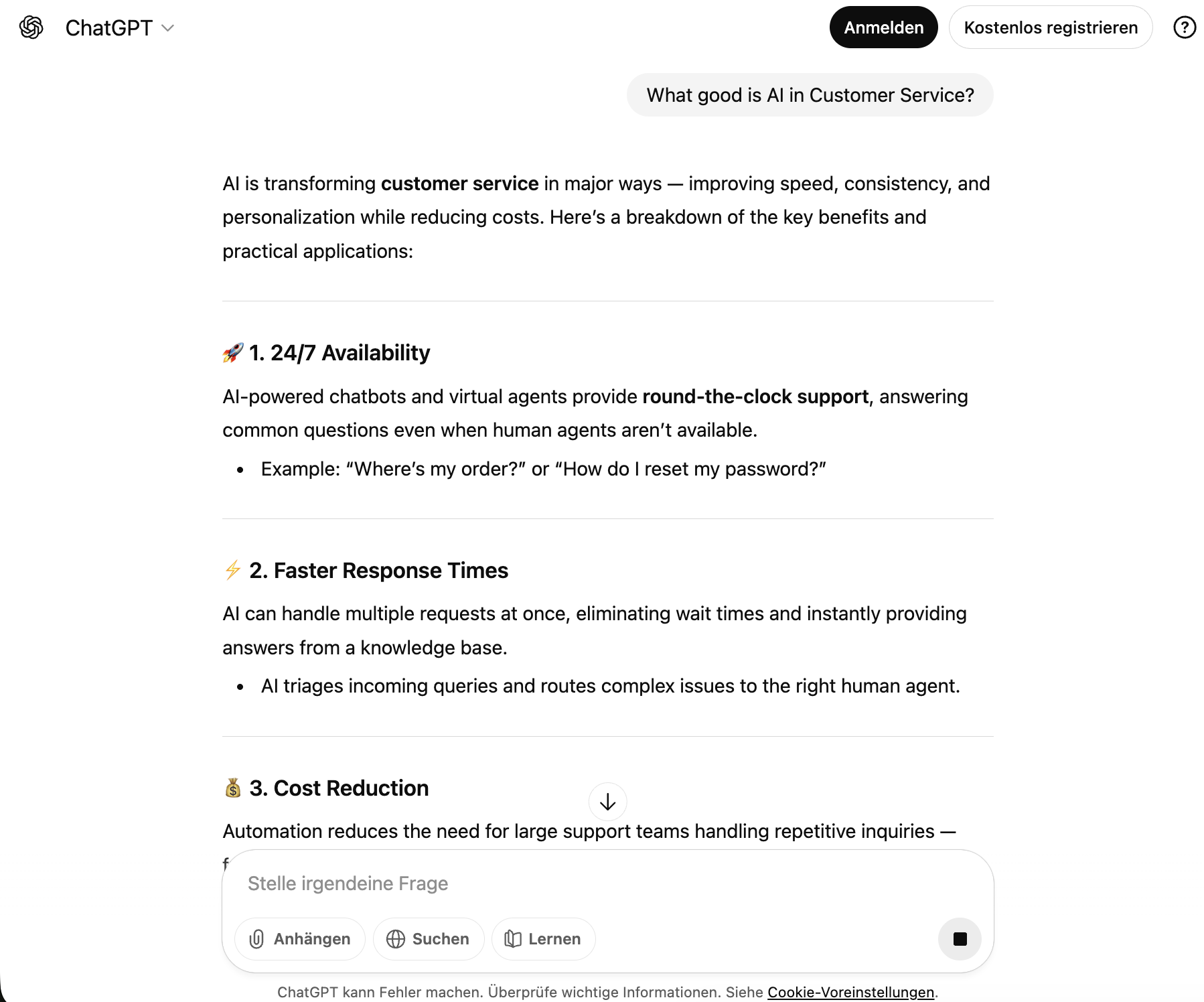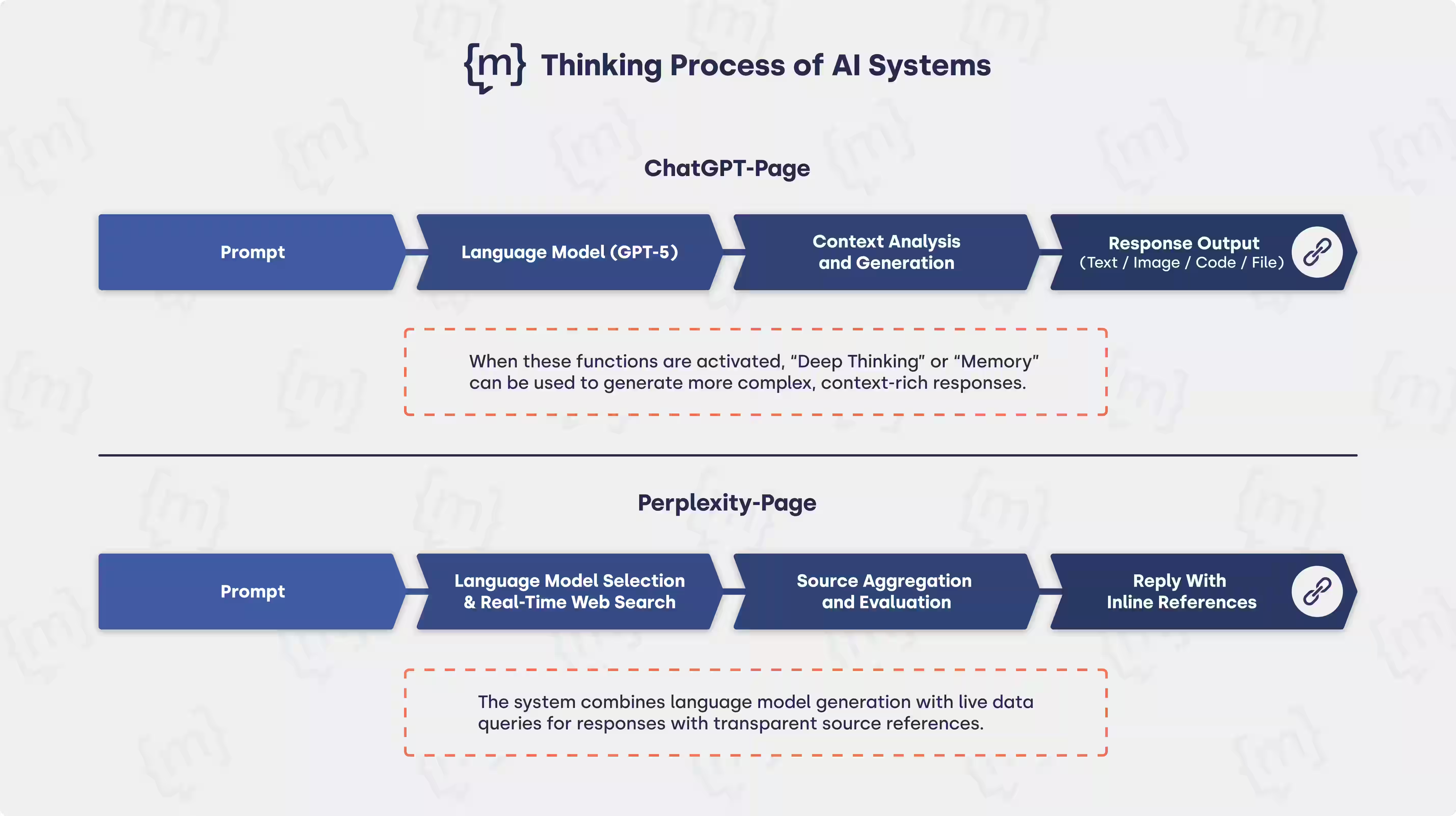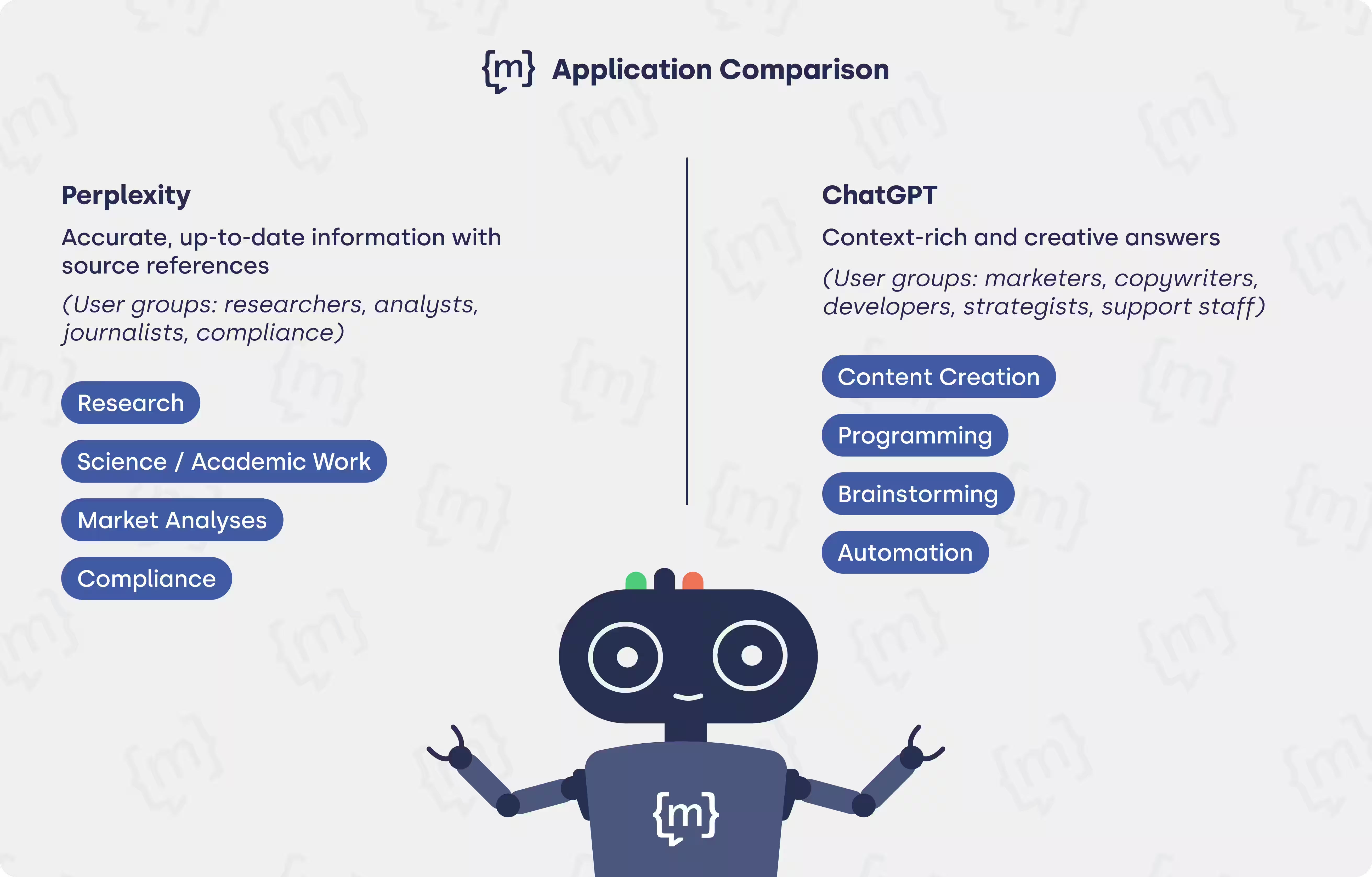To better understand how the tools work and what they focus on, here is an overview of Perplexity AI and ChatGPT, as well as their key features and areas of application:
What is Perplexity?
Perplexity is an AI-powered search assistant and chatbot introduced in 2022 by Perplexity AI Inc. Like ChatGPT, Perplexity also uses large language models and natural language processing. Unlike other AI chatbots, however, Perplexity does not rely solely on pre-trained data, but provides users with answers based on real-time web search functions. The AI actively retrieves current information from the web and quotes directly from sources in a dialogue-oriented format.
A major advantage of this approach is that it reduces hallucinations and outdated responses, making Perplexity particularly suitable for research and fact-checking. Users also have control over their search settings and can customize them as they wish, e.g., limiting the search to specific sources such as scientific papers. Here is an overview of Perplexity's key features:
- Real-time research and source-based answers: Perplexity cites accurate, up-to-date live data and information from the internet
- Multimodality: Processes text, images, PDFs, and audio in a single query
- Deep research function: Perplexity conducts autonomous, comprehensive research, and Perplexity Labs makes it possible to compile entire projects (including diagrams, images, reports) with a single query
- API integration: Enables integration into your own applications and systems with clear documentation and easy implementation
This flexibility, combined with robust search functions, makes Perplexity a powerful tool for anyone looking for detailed and verifiable information from the internet.
What is ChatGPT?
ChatGPT understands and generates language using machine learning methods, in particular artificial neural networks. Based on the LLM GPT (short for Generative Pre-trained Transformer) developed by OpenAI, ChatGPT continuously learns from data and independently recognizes patterns and correlations. The key features of ChatGPT summarized in a nutshell:
- Dialogue-oriented interaction: Designed for natural, context-based conversations
- Wide range of applications: According to OpenAI, the most common applications are text generation, automated customer communication, knowledge research and learning support, programming, and creative tasks (OpenAI Report, 2025). However, ChatGPT is not ideal for automated customer communication because it lacks specialized customization, brand identity, integration capabilities, and data control, among other things. For more information, see our article “ChatGPT in customer service: Does AI bring real added value?”
- Multimodality and adaptability: Inputs can now be made in the form of text, files, audio, and video, and individual instructions and role profiles can be defined
- Extensibility: Access to plugins, files, web browsing, and other tools (e.g., DALL·E). Particularly relevant in a business context: Connection to CRM systems for workflow automation
"Get answers. Find inspiration. Be more productive." OpenAI promotes ChatGPT as an AI-powered conversational system designed to help users with questions, ideas, productivity, and creativity.
What distinguishes Perplexity and ChatGPT
Perplexity AI and ChatGPT both aim to provide users with AI-powered responses in natural language, but they differ significantly in terms of technology, dialogue structure, and information processing.
Model Base of the AI
Perplexity combines powerful LLM models with its proprietary “Sonar” model, which is open source based and has been optimized for the standard use in the search and response platform. The integration of powerful third-party models, including Google Gemini, Anthropic/Claude, Meta/LLaMA, xAI/Grok, and OpenAI models such as GPT-4, offers flexibility. Which model is used depends on the selected plan (Free, Pro, or Max). In the paid versions, users can specify which LLM to use. If no model is selected manually, Perplexity automatically determines the most suitable model for fast, context-sensitive responses.
ChatGPT, on the other hand, is based exclusively on OpenAI's own GPT models. By default, 2025 GPT-5 and GPT-4o are used, while earlier versions such as GPT-4 or GPT-3 are still available in certain applications.
Data source and Timeliness
Perplexity uses a real-time web search with a focus on real-time sources. Answers are usually accompanied by source references, making it easier to verify results. This approach makes Perplexity particularly attractive for research and market analysis where timeliness is crucial. Here is an example: When asked “What can AI do in customer service?”, Perplexity responds with substantiated statements from the sources presented:

ChatGPT, on the other hand, works primarily on a model-based basis. The system generates responses based on the data used during training without accessing the web in real time by default. Although ChatGPT can retrieve current content via integrated browser and tool functions, its core function remains limited to pre-trained knowledge. Since May 2025, however, ChatGPT has offered advanced deep research functions that allow external sources to be searched specifically and incorporated into responses. This makes ChatGPT increasingly useful for up-to-date research. Unlike Perplexity, however, no source is specified for a query per se:

Interaction and Integration Options
While ChatGPT can be interpreted more as a dialogue-oriented assistant, Perplexity's interaction style is more like that of a response engine or search AI.
As an AI, Perplexity is strongly search- and response-centric. The focus is on quickly retrieving information that is backed up by source references and on providing precise, data-oriented answers. The “Comet” browser integration is particularly useful, as it allows users to ask questions and receive context-related answers directly while reading or researching.
The user experience is designed to deliver information as efficiently and reliably as possible, with a focus on inline search functions.
ChatGPT is a dialogue-oriented assistant designed for longer, coherent conversations. The system can perform creative tasks, write texts, develop ideas, or write code. Thanks to its memory function, ChatGPT remembers previous interactions and can take user preferences into account across sessions. Previous interactions are stored and incorporated into future chats. External data sources and tools can be integrated into the conversation via connectors or apps. These include Google Drive, GitHub, HubSpot, and others (see OpenAI integrations). For businesses, OpenAI also offers a so-called agent mode, which can perform actions independently, such as visiting websites, reading documents, or executing commands.
The ChatGPT user experience is deliberately designed for longer, context-rich conversations in which the AI acts as an assistance system.
This flow diagram, for each AI system respectively, summarized the process of the output given by the AI following a user prompt, the "Thinking Process" so to say:

What is the Pricing Structure for the Models?
Perplexity AI's pricing (Perplexity, 2025) can be summarized in the following main offers:
- Free (can be used without registration)
- Unlimited “quick searches,” limited to 3 “pro searches” with premium AI models per day
- File uploads possible
- Pro plan: $20/month or $200/year
- Over 300 Pro searches per day with a choice of premium AI models such as GPT-4, Claude 3, and similar
- Unlimited file uploads (PDFs, CSVs, audio, video, images
- AI image generation (e.g., DALL·E 3)
- Interactive “Copilot” assistant Comet
- Over 300 Pro searches per day with a choice of premium AI models such as GPT-4, Claude 3, and similar
- Enterprise Pro: $40/month per user
- All Pro features included
- Additional features for teams, e.g., admin tools and collaboration features
- Single sign-on (SSO), user management, audit logs, insights dashboard (for 50+ users)
- Dedicated enterprise support
- Enterprise Max plan: $325/month per seat, $3,250/year (16% discount)
- Unlimited access to the latest and most powerful AI models
- Unlimited research and labs queries
- Advanced configurability for data retention, audit logs, and team insights with no minimum number of seats
- Prioritized support
ChatGPT usage prices (OpenAI, 2025) are also available in several price and underlying function ranges:
- Free (can be used without registration)
- Restricted access to GPT-5 with limited messages and file uploads
- Basic functions, web browsing, and data analysis are very limited
- No option to create your own GPTs or tasks
- Suitable for occasional, private use
- Plus: $23 per month
- Extended access to GPT-5 with more messages and upload limits
- Audio and video mode (basic), advanced features such as custom GPTs and tasks
- Preview of experimental features (Sora 1)
- For creators and intensive users with moderate demands
- Pro: $229 per month
- Unlimited access to GPT-5 and GPT-5 Pro, no hard limits
- Unlimited advanced audio and video mode
- Access to advanced productivity features such as ChatGPT Agent, Codex Agent, Deep Research, and custom GPTs
- For power users, developers, researchers with high usage volumes
- Business: $29 per user/month (billed annually) / $34 monthly
- Minimum of 2 users required
- Unlimited GPT-5 access with data protection standard (no data usage for training)
- Admin tools, SAML SSO, MFA, compliance certificates (SOC 2, ISO)
- Team workspace, shared projects, tasks, connectors (Google Drive, GitHub, etc.)
- For teams and companies with security requirements and collaboration needs
- Enterprise: Individual, contractually agreed terms
- Most comprehensive range of features and highest security standards
- Dedicated infrastructure, global compliance, selectable data residency
- Prioritized 24/7 support
- For large enterprises with the highest requirements
The choice of model and corresponding functions therefore depend heavily on the selected tariff, and OpenAI's ChatGPT in particular imposes considerable restrictions on free users.
What are the disadvantages of Perplexity and ChatGPT?
Perplexity is less capable of dialogue and context awareness, which often makes longer conversations seem fragmented and is criticized by users. Users also complain that the search logic occasionally leads to excessive source dependency or that source references are unclear, for example by linking to secondary aggregators instead of original publications.
In contrast, the timeliness of ChatGPT's responses can be limited, especially when real-time web search is not active, as the timeliness of the data and knowledge base depends primarily on the data used during training. Analyses show that hallucinations, i.e., incorrect or fabricated responses, continue to occur. According to OpenAI, despite improvements, these remain “a persistent challenge.” (OpenAI, 2025) Other factors that affect usage are output reductions and hidden model changes.
Important for both applications: The quality of the results depends largely on the formulation of the input (prompting). The more precise and clear the query, the better the response. Both tools are also under continuous observation with regard to data protection and security as well as ethical use. In the case of Perplexity, for example, data transfer via third-party models is being discussed, while in the case of ChatGPT, cases of misinformation have been reported that are relevant in terms of data protection or reputation law. You can find out more about copyright and data protection in our article “ChatGPT: The 14 Most Important Questions + Answers”.
Which tool to use when?
In practice, choosing the right AI tool depends largely on the application scenario. For users, this means that if you have a task that requires creative thinking, a longer dialogue, or integration with your own data and work environment (e.g., document analysis, idea generation, personal assistance), then interacting with ChatGPT is more suitable, as it is designed for sustainability and depth. If you are looking for quick, fact-based answers, e.g., for research and inline search processes, then Perplexity is better suited to providing relevant sources and less to chatting.
The recommendation is to carefully weigh up the use case and, if necessary, use both tools complementarily to get the maximum benefit from the functionality of Perplexity and ChatGPT.
The following graphic summarizes the key characteristics of the two AI models and where best to use them:

Conclusion
In short: There is no “better” or ‘worse’ when it comes to using AI tools, but rather “suitable depending on the application.” Both tools offer integration options, with ChatGPT leaning more toward assistance and workflow embedding (plugins, connectors, agents), and Perplexity leaning more toward structured research sessions and a focus on answer quality and source transparency. To get started, it is recommended to begin with the free version to learn how the tools work and their limitations. In professional applications, it is advisable to critically examine the source references and always verify AI-generated content before reusing it.
Both systems are evolving rapidly. OpenAI is driving personalization and agent integration forward with GPT-5 and its “memory” features, while Perplexity is intensifying the expansion of its model diversity and access to real-time data. Users should pay particular attention to data protection measures and system transparency.
This is where moinAI comes in: our AI chatbot was developed specifically for automated customer communication, with a clear focus on transparency and data protection. Like Perplexity and ChatGPT, moinAI relies on dialogue-oriented query answering, but should be seen not as an alternative, but as a complementary, specialized solution that efficiently supports companies. This is how we combine the advantages of advanced AI with the requirements of professional customer communication.
[[CTA headline="The innovative power of modern LLMs with data and processes" subline="The AI chatbot from moinAI combines the innovative power of modern LLMs with your data and workflows." button="Jetzt testen!" placeholder="https://hub.moin.ai/chatbot-erstellen" gtm-category="primary" gtm-label="Jetzt testen!" gtm-id="chatbot_erstellen"]]





.svg)

